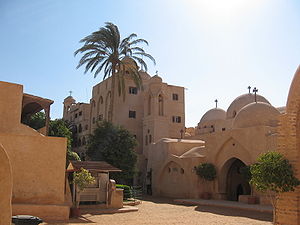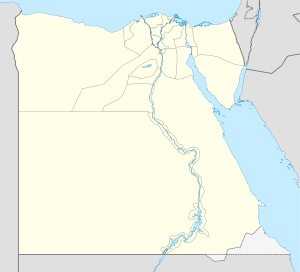- Wadi El Natrun
-
For other uses, see Natrona (disambiguation).
Wadi El Natrun Monastery of the Syrians in Wadi el Natrun Location in Egypt Coordinates: 30°35′N 30°20′E / 30.583°N 30.333°E Country  Egypt
EgyptGovernorate Beheira Time zone EST (UTC+2) – Summer (DST) +3 (UTC) Wadi El Natrun (Arabic for "Natron Valley"; Coptic: Ϣⲓϩⲏⲧ Šihēt "Measure of the Hearts", Greek: Σκετις or Σκετες "The Ascetics") is a valley located in Beheira Governorate, Egypt, including a town with the same name. The name refers to the presence of eight different lakes in the region that produce natron salt. In Christian literature, the region is also referred to as the Nitrian Desert. In ancient times, natron was mined here for use in Egyptian burial rites. It is believed that the Holy family visited Wadi El Natrun during their flight into Egypt.
Contents
History
The alkali lakes of the Natron Valley provided the Ancient Egyptians with the sodium bicarbonate used in mummification.
The region of Wadi El Natrun was and remains one of the most sacred regions in Christianity. Between the 4th century, when Saint Macarius of Egypt retired to the desert,[1] and the 7th century A.D., the region attracted hundreds of thousands of people from the world over to join the hundreds of monasteries of the Nitrian Desert. The desolate region became a sanctuary for the desert fathers and for cenobitic monastic communities. Many anchorites, hermits and monks lived in the desert and the hills around the region. The solitude of the Nitrian Desert attracted these people because they saw in the privations of the desert a means of learning stoic self-discipline (asceticism). Thus, these individuals believed that desert life would teach them to eschew the things of this world and allow them to follow God's call in a more deliberate and individual way.
Saints of the region
Some of the most renowned saints of the region include the various Desert Fathers, as well as Saint Amun, Saint Arsenius, Saint John the Dwarf, Saint Macarius of Egypt, Saint Macarius of Alexandria, Saint Moses the Black, Saint Pishoy, Sts. Maximos[disambiguation needed
 ] and Domatios, Saint Poimen The Great and Saint Samuel the Confessor.
] and Domatios, Saint Poimen The Great and Saint Samuel the Confessor.Monasteries
The importance of the region declined with the Muslim conquest of Egypt in 641 A.D. Many of the monasteries were destroyed and looted. Today, only four of the ancient fortified self-sufficient monasteries have survived, all of which date from the fourth century A.D.:
Saint-Exupéry
The environs of Wadi Natrun have been identified as the likely site of where the plane of French aviator Antoine de Saint-Exupéry crashed on December 30, 1935 - an experience which was documented in Saint-Exupéry's book "Wind, Sand and Stars" and in part inspired another of his books "The Little Prince".
Image gallery
-
Monastery of Saint Pishoy, Scetes, Egypt
-
Monastery of Saint Pishoy, Scetes, Egypt
-
Monastery of Saint Pishoy, Scetes, Egypt
-
Syrian Monastery, Scetes, Egypt
-
Frescos at the Syrian Monastery, Scetes, Egypt
-
Frescos at the Syrian Monastery, Scetes, Egypt
See also
References
- ^ "The first monk to settle in Wadi Natrun was Macarius the Egyptian, whose retirement to the desert took place in 330 A.D.." (Hugh G. Evelyn-White, "The Egyptian Expedition 1916-1919: IV. The Monasteries of the Wadi Natrun" The Metropolitan Museum of Art Bulletin, 15.7, Part 2: The Egyptian Expedition 1916-1919 [July 1920):34-39] p 34; Evelyn White's article gives a brief overview of Wadi Natrun from literary sources.
Further reading
- M. Cappozzo, I monasteri del deserto di Scete, Todi 2009 (Tau Editore).
External links
-
Wikimedia Foundation. 2010.









